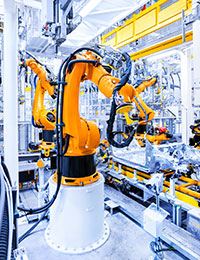Blog
Justifying Automation in Your Factory: Do’s, Don’ts and Advice from the Experts
Tweet This:
 Not too long ago, an automation cost benefit analysis still looked like the traditional Excel sheet structure, where customers factored in items that included average service life, hard operations and maintenance costs, versus items like labor savings and productivity gains. Sales discussions with prospects usually focused on three areas. First, how they could compete against overseas markets by reducing labor costs or headcounts, passing savings along through their supply chains. Second, whether industrial robots would outperform the productivity of employees who need breaks and work a much shorter day cycle. Third, whether robotic systems showed demonstrable improvements in increasing workplace safety and security.
Not too long ago, an automation cost benefit analysis still looked like the traditional Excel sheet structure, where customers factored in items that included average service life, hard operations and maintenance costs, versus items like labor savings and productivity gains. Sales discussions with prospects usually focused on three areas. First, how they could compete against overseas markets by reducing labor costs or headcounts, passing savings along through their supply chains. Second, whether industrial robots would outperform the productivity of employees who need breaks and work a much shorter day cycle. Third, whether robotic systems showed demonstrable improvements in increasing workplace safety and security.
As the industrial internet of things (IIoT) evolved into a definite business need, buyers became more interested in robot capabilities and their security infrastructures. The growing sophistication of these robotic systems meant buyers needed more assistance with their decision-making. That was especially the case as the COVID-19 pandemic drove the need for fully automated capable robots that could take over certain jobs, saving humans from the virus.
Over time, ROI analysis shifted from focusing on the quantitative machine and maintenance expenses to considering the qualitative aspects of the robotic system, such as the higher level of skills required in implementing and maintaining the IT process. It’s no longer enough to justify nominal machine costs. Now, customers need to have significant funds set aside for all these information system factors - overhead, maintenance and operating items - before they even consider investing in automation.
At one time, too, robot pricing almost exclusively focused on hard operations and maintenance costs. Now, it’s become less straightforward, shifting to intangible costs and benefits. These include how to attract and retain high-quality employees, how to keep employees safe on and off the workforce, how to ensure endpoint security, particularly as workplaces transition remote, how to be prepared for and anticipate crises and how to maintain strict robot compliance with COVID-19 social distancing regulations.
Not that the tangible calculations are forgotten.
Tangible variable costs include labor, energy, materials, ongoing maintenance and production supplies. Intangible costs include training and management overhead as well as ergonomic issues and questions of employee wellness and safety. Tangible benefits are increased efficiency, eliminated redundancies, and reduced labor costs, among others. Intangible benefits include improving communication, reducing work-in-process inventory by combining operations and increasing employee safety and retention.
With the advent of the pandemic, other metrics that prospects typically consider include how to inspire and incentive their work-from-home employees, and, if working onsite, how industry robots can maintain compliance with social distancing guidelines.
Customers also want to know whether it would be worthwhile to invest more on autonomous robots that perform the mundane tasks, freeing human employees for more high-value projects, or whether the buyer would be better served with collaborative robots, where humans and robots work collaboratively. These and similar decisions all revolve around the buyer’s business objectives, situation, needs, budget, size of workplace and so forth. And that's why communication is crucial to successful sales.
Successful consultants recognize that there are three parties in the sales transaction: The automation supplier, the machine operator/ engineer and the end-customer. Both engineer and customer have their own relationships to the purchase, and, therefore, each needs to be involved in the sales discussion. For programmers, it’s their working connection to the machine. For customers, it’s the desired results. The consultant needs to thoroughly address their various concerns to justify the costs of their investment.
Questions to ask include: Why is the customer buying the machine? What do they want out of the tool? Which projects do they want the machine to address? What are their primary goals?
提高效率和减少劳动力成本最高ost lists, but today’s employers also seek machines that impact the bottom line of their business quickly in other ways too. These include boosting employee retention (especially in today’s workforce), maintaining workforce stability, and working with a customized solution that's easy to use. That’s especially critical for first-time buyers who also agonize over the commitment that automation requires.
The future of automation aggravates automation ROI calculations, as customers face a broader range of robots from the relatively simple autonomous mobile robots (AMR) to more sophisticated collaborative robots and vision-guided robots. Each machine provides different benefits and meets different needs. Collaborative robots work with humans, AMR robots are typically deployed for mundane autonomous tasks, while vision-guided robots are more flexible and productive - and far more expensive. Some robotic systems may require greater initial investment but can swiftly offset the expense of both the technology and the integration process down the line.
Would you like to learn more? Watch our webinar:How to Justify Automation.
Recent Posts
- 图像传感器在novations Push Machine Vision Forward
- The Benefits of Remote Monitoring, Remote Programming & Predictive Maintenance
- Machine Vision Inspection: Tools of the Trade
- AI Applications In The Global Supply Chain
- Application Stories: Highlighting Automation Benefits
- Innovative Technologies Emerge to Meet Evolving Machine Vision and Imaging Challenges
- View All

